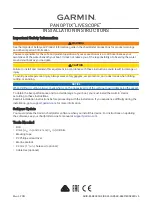
Footswitch Board
4-16
Force FX-8C Service Manual
the associated photo-transistor to conduct. The collectors of the transistors
are connected to input pins of an I/O port on the microcontroller where
they activate the desired mode of operation.
Audio Circuit
The audio system consists of an audio oscillator, tone control signals, a
volume control potentiometer, an audio amplifier, and a speaker. A
reference voltage (Vref) is used throughout the audio circuit and is
generated by dividing the +12 V power supply down to about 2 V by R9
and R8.
The audio circuit annunciates the presence of RF output and provides an
auditory indication of alarm conditions. A potentiometer adjusts the
volume of RF output activation tones. The speaker volume cannot be
turned off entirely. The volume of the tone issued during alarm conditions
is not adjustable.
The audio oscillator is enabled when UP_TONE\ or RF_TONE\ is pulled
low. Diodes D1 and D2 provide a wired OR function for the two signals.
Since UP_TONE\ and RF_TONE\ are +5 V (logic level) signals, resistors
R4 and R6 divide the +12 V audio power supply down to about 4.85 V to
prevent D1 and D2 from sourcing current into the output pin of U3 on the
Control board. When either UP_TONE\ or RF_TONE\ is enabled low, the
voltage at the noninverting input of U1B is pulled below the Vref
threshold present at U4B’s inverting input, the open collector output of
U4B is turned on, grounding R31 and allowing U6A to oscillate.
U6A is a relaxation oscillator whose frequencies are determined by the RC
time constants of R30, C35, and C18. This design allows the oscillator to
produce two distinct frequencies that can be selected by the state of the
LO_TONE signal.
• When LO_TONE is not asserted, R30 and C35 determine the frequency
of operation of the oscillator (approximately 900 Hz).
• When LO_TONE is asserted (+5 V), the voltage at the noninverting
input of U4A exceeds the 2 V Vref signal at the inverting input, turning
on its output transistor. This effectively connects C18 in parallel with
C35 to produce a higher RC time constant for the oscillator, which
results in a lower audio frequency of approximately 700 Hz.
The ALARM signal selects the user-controlled audio volume or the fixed
alarm level volume. U1C and U1D are configured in an exclusive OR
arrangement in which the state of the output transistors of U1C or U1D is
complementary. In other words, the output transistor of one of these two
devices is always on, but both cannot be on simultaneously. Under normal
operating conditions, the ALARM signal is low, allowing the U1C output
to float while the U1D output transistor is turned on. The output of U1D
creates a voltage divider through R11, R12 (the volume control
potentiometer), and R32 to attenuate the audio signal to levels acceptable
for input to the audio amplifier. R32 determines the maximum audio
volume and R11 determines the minimum audio volume. R10 determines
the audio alert volume level. R34 provides an alternate audio signal path
in the event of an open volume control potentiometer.
Summary of Contents for Force FX-8C
Page 1: ...Service Manual Force FX 8C Electrosurgical Generator with Instant Response Technology...
Page 30: ...Notes 2 12 Force FX 8C Service Manual...
Page 56: ...Notes 3 26 Force FX 8C Service Manual...
Page 58: ...Block Diagram 4 2 Force FX 8C Service Manual Block Diagram...
Page 84: ...Notes 4 28 Force FX 8C Service Manual...
Page 156: ...Interconnect Diagram 7 2 Force FX 8C Service Manual Interconnect Diagram...
















































